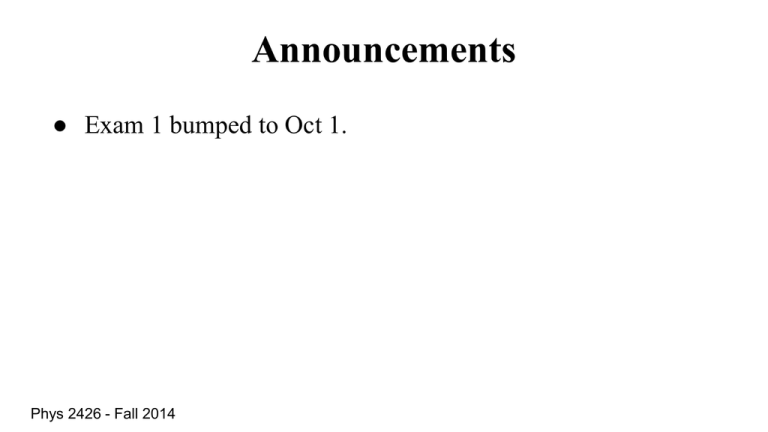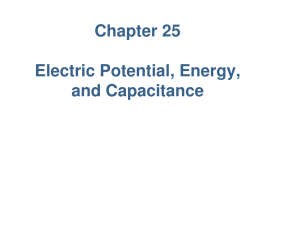Phys2426-2014-09-03 Lecture 2.pptx
advertisement

Announcements ● Exam 1 bumped to Oct 1. Phys 2426 - Fall 2014 Charged Objects ● Typically q=0 because there are equal numbers of ⊕ and ⊖ charges in normal matter. ● Charge is given to an object by adding or removing electrons (e−). Here, Ne is the number of extra or missing e−. Phys 2426 - Fall 2014 Example How can an object have 64 nC of charge? Phys 2426 - Fall 2014 Electric Field Caused by “source charges” (I.e. everything but “test charges”.) ● Direction o o Points “downhill” on the Electric Potential (V) landscape. Points away from ⊕ and toward ⊖. ● Strength o o Measured in newtons per coulomb (N/C). Also measured in volts per meter (V/m). (I.e. E is the slope of V.) Phys 2426 - Fall 2014 Point Charge ● ● ● ● ● Contribution is: This is because the contribution to V is: k is the “Coulomb Constant”: r is our distance from the Point Charge. Note: Both E and V get smaller as we move further away. Phys 2426 - Fall 2014 Distributions of Charges (Method 1) ● Each “bit” of the line charge contributes to the E-Field Phys 2426 - Fall 2014 Charge Densities Volume: Surface: Linear: Phys 2426 - Fall 2014 Example 23.8: Ring of Charge a is radius of ring x is position of P r is distance from dq to P Phys 2426 - Fall 2014 Surface Charge σ is Charge per Unit Area 2-D double integral gives us a solution: Doesn’t depend on position − it is “Uniform”! Phys 2426 - Fall 2014 Effect of E-Field: Causes Force Here, q0 is the charge “experiencing” the electric force. This force can do things other forces can do: ● Cause an acceleration (if it’s the only force in that direction) ● Help balance out other forces Phys 2426 - Fall 2014 Example: Electrostatic Levitation A 0.5 g piece of styrofoam has a charge of 50 nC. What electric field is required to levitate it? Phys 2426 - Fall 2014 Example: Electrostatic Levitation A 0.5 g piece of styrofoam has a charge of 50 nC. What electric field is required to levitate it? Phys 2426 - Fall 2014 Example: Electrostatic Levitation A 0.5 g piece of styrofoam has a charge of 50 nC. What electric field is required to levitate it? Phys 2426 - Fall 2014 Electrostatic Levitation: How? To make a ⊕ bead levitate: ● The electric force must point which way? ● The E-Field must point which way? ● We could “paint” the floor with what charges? Phys 2426 - Fall 2014 What charges are in the bead? ● ● ● ● ● ~50% of most objects comes from the protons. The mass of a proton is mp = 1.67 × 10-27 kg The number of protons in the bead is: The charge of these protons is: So the charge of all of the electrons is Qe = −24000 C Phys 2426 - Fall 2014 What about the “charged” bead? ● The neutral bead has Qp = −Qe = 24000 C ● The charged bead has the magnitude of Qe reduced by 50 nC. So, Qe = −23999.999999950 C ● Of course, the 24000 C was an approximation. But the net charge of 50 nC is not hard to measure. Phys 2426 - Fall 2014 Why else is the E-Field Important? Dielectric Strength is how much E-Field a material can take. Exceeding this value causes sparks, short circuits, and/or lightning. For air, the dielectric strength is about 106 V/m. Phys 2426 - Fall 2014

